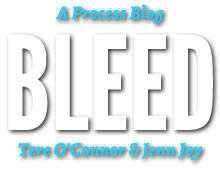As I have mentioned, I make a ton of movement to begin. It’s like creating artifacts of thought. I discover the movement ingredients for each work from a somewhat inchoate self and simultaneously objectify these as autonomous entities. But a division appears rather quickly in the process for me and I have arrived there this week. These initial, free moments of experimentation and rumination are quickly disturbed by premature cries from the future to finish the work. Like the point in an estuary, where salt water meets fresh to create brackish water, a negotiation between allowance and calculation begins and is turbulent. Usually at this juncture I try some possible structures to stabilize things, intuitively stitching together sections of material to create an early schema for the final structure. I am placing materials with very different characteristics, created at separate times, into catenation to see what erupts or fades away. Sections that looked completely resolved on their own get stirred up when placed into these assemblages. I will tear this apart and create new structures many, many times. Certainly this process gives me cues to the moment when a balanced structure will finally gel, but deep down I know it is too early. There is something more resonant, more complex and unknowable to come. This clutch between intuition and objectivity fuels the choreographic mind. It is one of the thousand dualities that a choreographer must reside in lest she make premature decisions based on the rational.
Bashing out these possible structures starts to reveal what the connective tissue between the diverse parts of a work might be. But from where do we get that information? How do we read the dance to find what its poetics are made of? Things connect by shape or tone or intention or rhythm or inference or numerology or persona or reference or any of a multitude of qualities. I used to look for a single answer but it has been my experience that these must all be considered. They are what I call categories of difference for myself, all the disparate ideas that begin to show up and live inside of one work. These elements will be entangled in the final structure, woven together so a viewer can actively, if not consciously, shift from one potential reading to another as opposed to looking for the author’s view. This is the main attraction I have for choreography. Working on it never seems to bring me to the definitive. If I try to push towards any “overall” concept it won’t work. By constantly shifting structure, and regrouping the different parts I activate articulations that I could not find in any other way. The big, old word recontextualization really is important for me. It is an action I am engaged in constantly. It is what happens to words in poetry when they find themselves imbricated in new constructions and it is similar with movement material. It is the route to the transcendent complexity that defines the choreographic practice for me.

Tere, can you speak to “the transcendent complexity”, in particular the transcendent part?